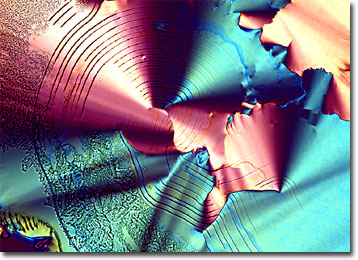Polarized Light Microscopy Digital Image Gallery
Polybenzyl L-Glutamate (PBLG)
Though matter used to be classified primarily as a solid, liquid, or gas, in the late nineteenth century it was discovered that some liquids possess certain qualities of a solid. The term liquid crystal was coined to describe such substances by German physicist Otto Lehman.

View a second image of Polybenzyl L-Glutamate (PBLG)
The very first liquid crystalline phases observed were found in derivatives of cholesterol and were accordingly dubbed cholesteric, a term that is used to denote any liquid crystal that exhibits an ordering of molecules similar to these early examples. Cholesteric liquid crystals form in layers that are only a molecule thick, and within each of the layers, the component molecules are ordered with their long axes in the plane of the layer and parallel to each other, analogous to a liquid crystal in a two-dimensional nematic phase. However, unlike nematic liquid crystals, the layers formed during a cholesteric phase are stacked in a rotating, helical manner. In fact, cholesteric phases are only exhibited by chiral compounds.
Transitions into liquid crystalline phases may be stimulated either by changes in temperature (thermotropic liquid crystals) or concentration (lyotropic liquid crystals). Polybenzyl L-glutamate (PBLG) is an example of a lyotropic liquid crystal that develops stiff helical rods in many organic solvents. These rods have often been observed to exhibit a cholesteric ordering. Similar to other substances that exhibit cholesteric phases, PBLG solutions experience a modulating refractive index due to the Bragg scattering of various colors of light caused by the helical organization of the liquid crystals.
